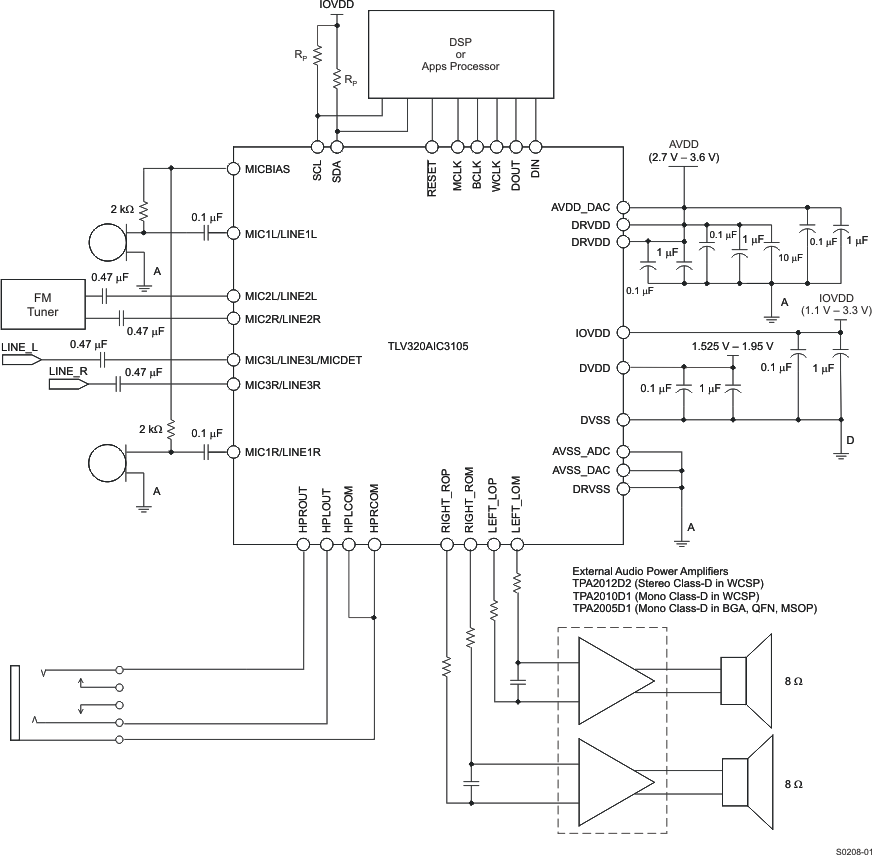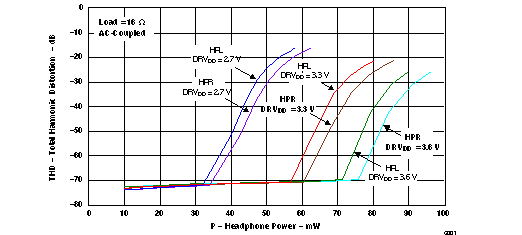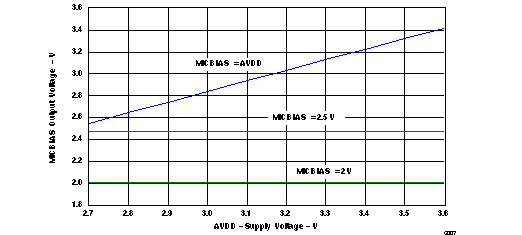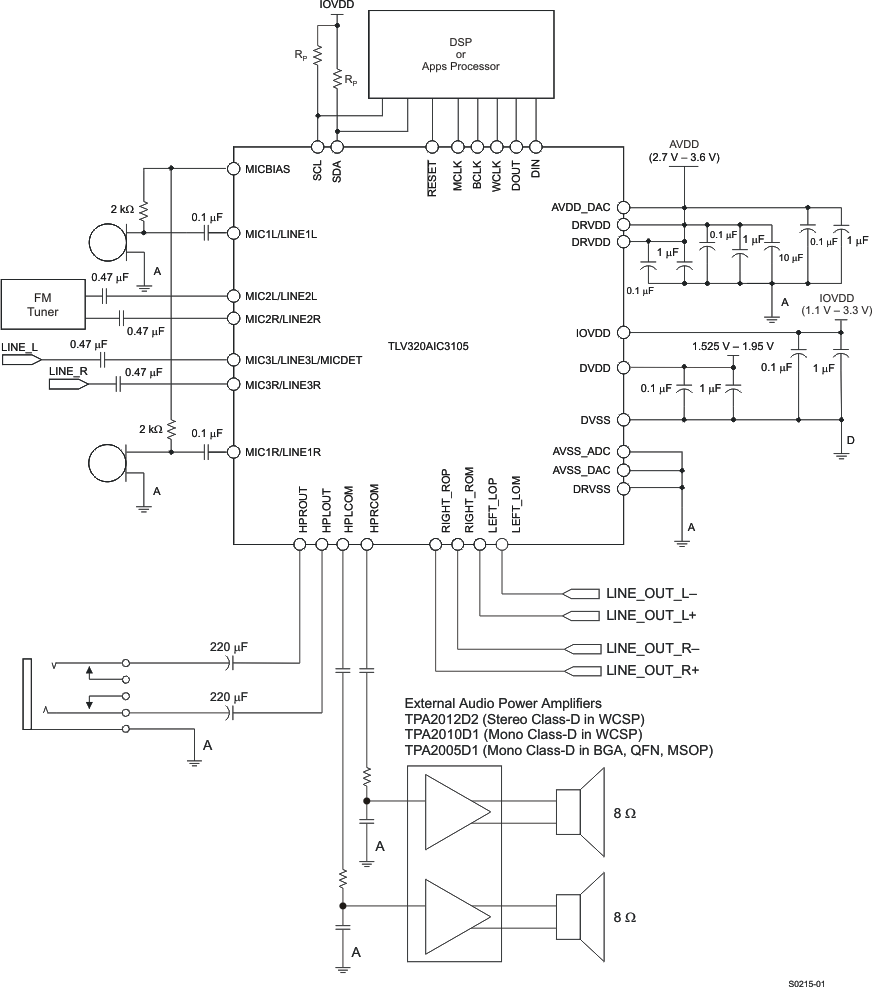SLAS513C February 2007 – December 2014 TLV320AIC3105
PRODUCTION DATA.
- 1 Features
- 2 Applications
- 3 Description
- 4 Revision History
- 5 Description (Continued)
- 6 Related Devices
- 7 Pin Configuration and Functions
- 8 Specifications
- 9 Parameter Measurement Information
-
10Detailed Description
- 10.1 Overview
- 10.2 Functional Block Diagram
- 10.3
Feature Description
- 10.3.1 Hardware Reset
- 10.3.2 Digital Control Serial Interface
- 10.3.3 Audio Data Converters
- 10.3.4 Audio Analog Inputs
- 10.3.5 Analog Fully Differential Line Output Drivers
- 10.3.6 Analog High-Power Output Drivers
- 10.3.7 Input Impedance and VCM Control
- 10.3.8 MICBIAS Generation
- 10.3.9 Short-Circuit Output Protection
- 10.3.10 Jack and Headset Detection
- 10.4 Device Functional Modes
- 10.5 Programming
- 10.6 Register Maps
- 11Application and Implementation
- 12Power Supply Recommendations
- 13Layout
- 14Device and Documentation Support
- 15Mechanical, Packaging, and Orderable Information
パッケージ・オプション
メカニカル・データ(パッケージ|ピン)
- RHB|32
サーマルパッド・メカニカル・データ
- RHB|32
発注情報
11 Application and Implementation
NOTE
Information in the following applications sections is not part of the TI component specification, and TI does not warrant its accuracy or completeness. TI’s customers are responsible for determining suitability of components for their purposes. Customers should validate and test their design implementation to confirm system functionality.
11.1 Application Information
The TLV320AIC3105 is a highly integrated low-power stereo audio codec with integrated stereo headphone/line amplifier, as well as multiple single-ended inputs and single-ended or fully differential programmable outputs. All the features of the TLV320AIC3105 are accessed by programmable registers. External processor with I2C protocol is required to control the device. It is good practice to perform a hardware reset after initial power up to ensure that all registers are in their default states. Extensive register-based power control is included, enabling stereo 48-kHz DAC playback as low as 14-mW from a 3.3-V analog supply, making it ideal for portable battery-powered audio and telephony applications.
11.2 Typical Applications
11.2.1 Capless Headphone and External Speaker Amp
 Figure 33. Typical Connections for AC-Coupled Headphone Out With Separate Line Outputs and External Speaker Amplifier
Figure 33. Typical Connections for AC-Coupled Headphone Out With Separate Line Outputs and External Speaker Amplifier
11.2.1.1 Design Requirements
Table 178. Design Parameters
| PARAMETER | VALUE |
|---|---|
| Supply voltage (AVDD, DRVDD) | 3.3 V |
| Supply voltage (DVDD, IOVDD) | 1.8 V |
| Analog high-power output driver load | 16 Ω |
| Analog fully differential line output driver load | 10 kΩ |
11.2.1.2 Detailed Design Procedure
- Use the Typical Application Schematic as a guide, integrate the hardware into the system.
- Following the recommended component placement, schematic layout and routing given in the Figure 38 below, integrate the device and its supporting components into the system PCB.
- For questions and support go to the E2E forums (e2e.ti.com). If it is necessary to deviate from the recommended layout, please visit the E2E forum to request a layout review.
- Determining sample rate and Master clock frequency is required since powering up the device as all internal timing is derived from the master clock. Refer to the Audio Clock Generation section in order to get more information on how to configure correctly the required clocks for the device.
- As the TLV320AIC3105 is designed for low-power applications, when powered up, the device has several features powered down. A correct routing of the TLV320AIC3105 signals is achieved by a correct setting of the device registers, powering up the required stages of the device and configuring the internal switches to follow a desired route.
- For more information of the device configuration and programming, refer to the TLV320AIC3105 technical documents section in ti.com (http://www.ti.com/product/TLV320AIC3105/technicaldocuments).
11.2.1.3 Application Curves
 Figure 34. Headphone Power vs THD, 16-Ω Load
Figure 34. Headphone Power vs THD, 16-Ω Load
 Figure 35. MICBIAS Output Voltage vs AVDD
Figure 35. MICBIAS Output Voltage vs AVDD
11.2.2 AC-Coupled Headphone Out With Separate Line Outputs and External Speaker Amplifier
 Figure 36. AC-Coupled Headphone Out With Separate Line Outputs and External Speaker Amplifier
Figure 36. AC-Coupled Headphone Out With Separate Line Outputs and External Speaker Amplifier
11.2.2.1 Design Requirements
Refer to the previous Design Requirements section.
11.2.2.2 Detailed Design Procedure
Refer to the previous Detailed Design Procedure section.
11.2.2.3 Application Curves
Refer to the previous Application Curves section.